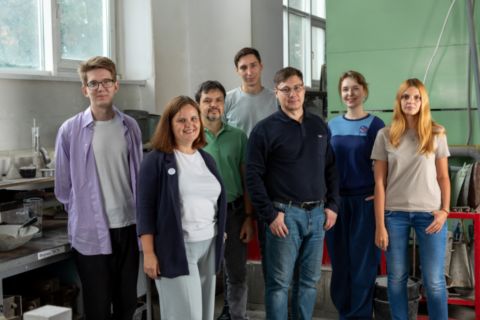Scientists of South Ural State University have patented a unique self-cleaning concrete based on sludge. The new building material is biologically safe and can be used to keep the exterior of buildings clean.
Such concrete can autonomously decompose organic contaminants from exhaust gases, smoke and industrial emissions on its surface, which are then easily washed away by rain. The miracle of this transformation is ensured by sludge (waste from paint and varnish production) added to the concrete mixture. And though this byproduct of the chemical industry is hazardous, it can also bring much benefit.
The thing is that this sludge contains mostly gypsum, which is part of mixed binders for concrete. However, in addition to its binding properties, such gypsum is unique because it contains titanium dioxide in the form of anatase, a rare natural mineral. In this form, titanium oxide becomes a powerful photocatalyst. Working as an accelerator of chemical processes, titanium dioxide is activated (only) under the influence of sunlight, decomposing hazardous substances on the surface of the material through a powerful oxidation reaction into harmless substances, which are then naturally removed in bad weather. Thus, sludge becomes a valuable and, importantly, cheap main component for self-cleaning concrete surfaces.
.jpg)
“We use sludge that already contains titanium dioxide in the active form of anatase,” says Professor of the SUSU Department of Building Materials and Products Tamara Chernykh. “It is very difficult to extract it from there, because it is just a by-product of paint and varnish production. Manufacturers use titanium white pigment, so titanium oxide is contained in large volumes in waste. In our case, it is ordinary gypsum, but with a large amount of active photocatalyst in it. A photocatalyst in its pure form is very expensive, and sludge enriched with it is a cheap product of industrial processing that can serve us well.”
Scientists of the SUSU Department of Building Materials and Products prepared samples of finishing tiles from sludge raw materials of the Crimean paint and varnish plant. It consists of gypsum isolated from waste with titanium dioxide, cement and a pozzolanic component (microsilica or fly ash) to increase the moisture resistance of the building material. According to scientists, the tile is quite durable and lightweight, and its colour and texture can vary.
Gypsum, extracted from paint and varnish sludge, as a binding and self-cleaning component, can also used for wall panels, facade plaster and mineral paints. It is important that after processing (roasting, grinding and drying), the sludge becomes an absolutely safe raw material, and the final product is quite inexpensive. In addition, gypsum building materials are recognized as more environmentally friendly compared to the cement ones.
Up until now, no one in the world has ever used waste paints and varnishes as a source of waterproof gypsum with a natural photocatalyst for the production of building concrete with self-cleaning properties. SUSU scientists came up with this idea due to a long-term environmental problem. For more than twenty years now, on the territory of a former Chelyabinsk paint and varnish plant there have been sludge reservoirs - “pools” with an acidic viscous substance three meters deep. The floodplain of the Miass River is in close proximity to industrial waste, which enters its water with rain and poisons the river fauna. The pH level of the sludge is so low that due to excessive acidification of the surrounding soil, all vegetation in the area dies. Chelyabinsk developers plan to recycle local sludge accumulations to produce innovative self-cleaning concrete, while also solving a serious environmental problem.
The project is being implemented within the framework of the Science and Universities national project.




